So one or more of the outlets in your home isn’t working. What do you do when all of a sudden an outlet doesn’t have power?
An outlet can stop working for a variety of reasons. Most commonly, it occurs when a circuit gets overloaded because you’re running too many appliances/equipment/devices at the same time, but it can happen because of problems with a few other common electrical components as well.
Fortunately, troubleshooting an outlet that isn’t working is not difficult and doesn’t require any special knowledge. Let me show you how.
How To Fix An Outlet: Step-by-Step Guide
In this tutorial, I’m going to walk you step by step through three basic troubleshooting methods for outlets that have stopped working. With these simple procedures, you should be able to restore power to your outlets without spending a bunch of time, without buying any tools, and without calling in a pro.
I’ll also be explaining in simple terms the problems or “faults” you can have within an electrical circuit, why they’re dangerous, and how you can use GFCI and AFCI electrical components to guard against these dangers.
If you’re totally new to home maintenance, this is a good introductory article to get you started with DIY electrical repairs. At the end of the post, you’ll find links to additional resources helping you save time and money around the house.
Rather watch than read? Check out this 9-minute video.
Troubleshooting Tip #1: Check the Electrical Panel and Circuit Breakers
I’m using a pair of duplex outlets as my first example. I plugged in the battery charger for my electric chain saw and nothing’s happening. The outlet isn’t working.
Our first tactic is simply to go to the electrical panel and see if we can find any issues.
My electrical panel is located in the garage but yours could be in any number of places — in the basement, in a clothes closet, in a utility room/closet, even on the exterior of the house — depending on the age of your home and where you live.
Understanding the Function of Breakers and Fuses
The breakers on an electrical panel (or fuses, if you have an older system) control power to the electrical circuits in your house.
My panel, for example, has 200 amps of power coming into the panel, which is then distributed throughout the house in the form of individual circuits. You could think of the circuits as the branches of an electrical tree.
Most of the circuits in your home are 20 or 15 amps at 120-volts.
If you have breakers, you’ll find the amp rating for each circuit on the breaker switch.

The thin breakers (such as 20-amp) are for 120-volt circuits. The thick breakers (where the breaker switch is twice the size of the thin breaker) are for 240-volt circuits.

If you have an older electrical system, you might have fuses instead of breakers.
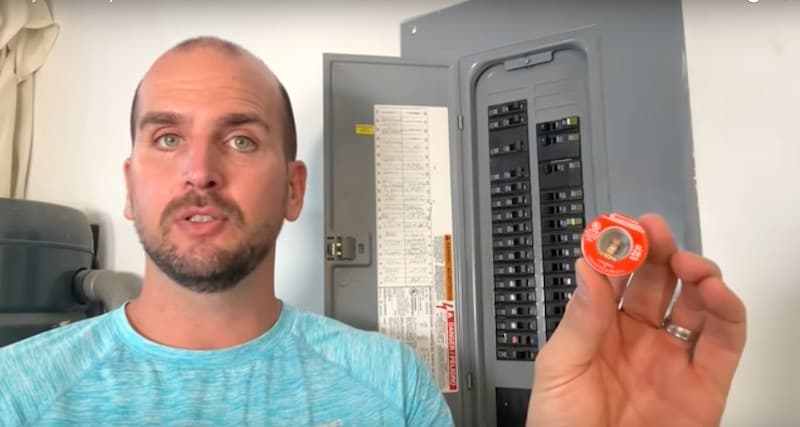
A fuse serves the same purpose as a breaker but it works in a different way. Inside the fuse is a “sacrificial” piece of metal. If the load on the circuit exceeds the maximum amperage of the fuse, the piece of metal will burn up and break the circuit, cutting off the power. If this happens, you’d need to replace the fuse to get your circuit back up and running.
Obviously, having breakers is more convenient.
Now to reset mine.
Resetting the Breaker
If your outlet is not working because of a tripped breaker, you’ll see the breaker lever in the middle position (between ON and OFF), and perhaps also an orange indicator on the breaker itself, depending on the brand of breaker you have.

To reset the breaker, push the switch to the OFF position and then to the ON position.
Causes of a Breaker Being Tripped
Tripping a breaker or blowing a fuse is a common occurrence. It’s frequently caused by appliances that produce heat —a space heater, a hairdryer, a toaster oven— because these things draw a lot of power. All that power being pulled through the circuit overloads it because you’ve exceeded the amperage threshold of the wiring in the circuit.
NOTE: A breaker that is continually tripping could be a sign of an issue with the configuration of your circuitry. In this case, you’ll want a professional to take a more in-depth look.
If resetting the breaker didn’t fix your problem, no worries. Troubleshooting Tips 2 and 3 are coming up.
Troubleshooting Tip #2: Check GFCI Receptacles
Our second method for getting power flowing back to your outlet has to do with GFCI receptacles.
GFCI stands for Ground Fault Circuit Interrupter. In short, these receptacles protect you from electrical shock.
What is a Ground Fault/How a GFCI Outlet Works
GFCI outlets are typically found in places where there’s moisture — kitchens, bathrooms, laundry rooms, garages. and outside. They are basically a watchdog that senses when there’s an interruption in the normal flow of electricity between the hot side of the outlet (where the smaller prong is inserted) and the neutral side (where the bigger prong goes).
This “interruption in the flow” can also be thought of as leakage of the current. The leaking current is going to look for a path to the ground, and that path could be your body! This is what happens when you get an electrical shock.
SAFETY NOTE: Any time electrical current starts traveling somewhere it shouldn’t, we have a dangerous situation on our hands. This is not to be taken lightly. Getting an electrical shock certainly isn’t fun but never forget that electrical malfunction can result in serious harm, even death.
A GFCI can detect a disruption in the flow of as little as 5-10 milliamps (1 one-thousandth of an amp). When it senses this disruption, it trips, breaking the circuit and stopping the flow of electrical current.
NOTE: When the GFCI trips, it will cut the power to everything on the same circuit.
The Buttons on a GFCI Receptacle
GFCI outlets can have different designs but they always have two buttons: a “Test” button and a “Reset” button. The placement of the buttons can vary.
You can see in my examples here that the buttons are on top of each other in the receptacle on the left, and side by side in the one on the right.
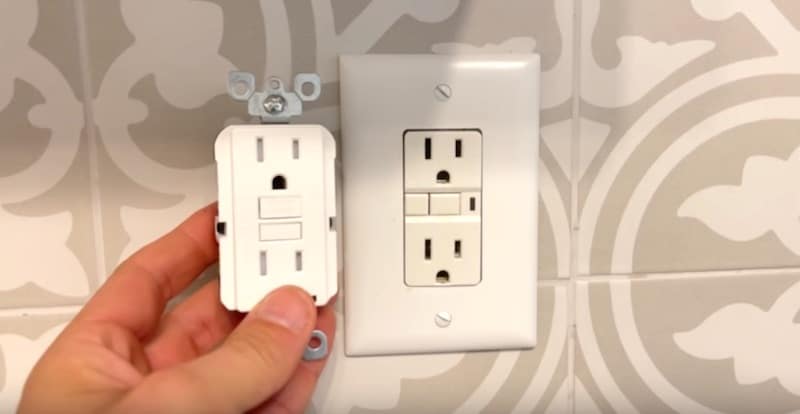
The purpose of the buttons is exactly what you infer from their names.
The Test button does just that — it tests the functionality of the GFCI feature. These receptacles can fail with the passage of time. The Test button is there to make sure the GFCI is working properly.
Using the Reset button on the GFCI is much like switching the breaker back to the ON position at your electrical box. When you press it, it resets the GFCI and the circuit.
GFCIs manufactured in the last ten years should have a tiny light somewhere on the receptacle. When the outlet is working normally, these lights can be off or they can glow green depending on the brand.
In the case of my GFCI, the light is off when the outlet is working.
When the GFCI trips, the light turns amber.
Resetting the GFCI
For demo purposes, I’m going to press the Test button, which will also give me an amber light.
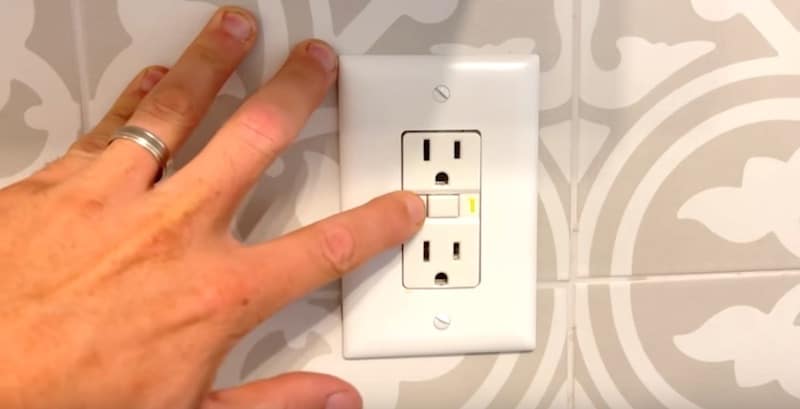
With the GFCI Test button pressed, there is no longer power flowing to the outlet.
If a tripped GFCI is your issue, just pressing the Reset button is the simple solution to getting your outlet working again. You might need to press the button pretty far in to get it to hold, but once the GFCI is reset, power will be restored to the circuit.
NOTE: A single GFCI outlet will provide protection to all the outlets downstream of it, even if those outlets are standard (non-GFCI) receptacles.
For example, the GFCI outlet I’m pointing to in this kitchen is also providing GFCI functionality to the outlet where the coffee maker is plugged in.
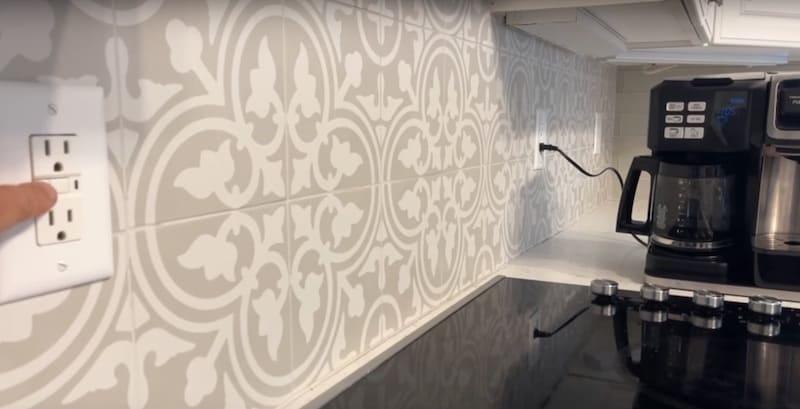
The outlet for the coffee maker is a standard outlet, but if I trip the GFCI, I’ll cut off power to the coffee maker as well.
So if you have a standard outlet that’s not working, look around for a GFCI receptacle on the same circuit. A tripped GFCI could be the source of the other outlet not having power.
Having said that, finding the GFCI may take a little detective work.
Let’s go out to the garage for an example.
Back to my duplex outlet that’s not working. It’s connected to a GFCI outlet that’s all the way across the room and behind some stuff on a shelf! So I’ll move the cleaning supplies and reset the GFCI.
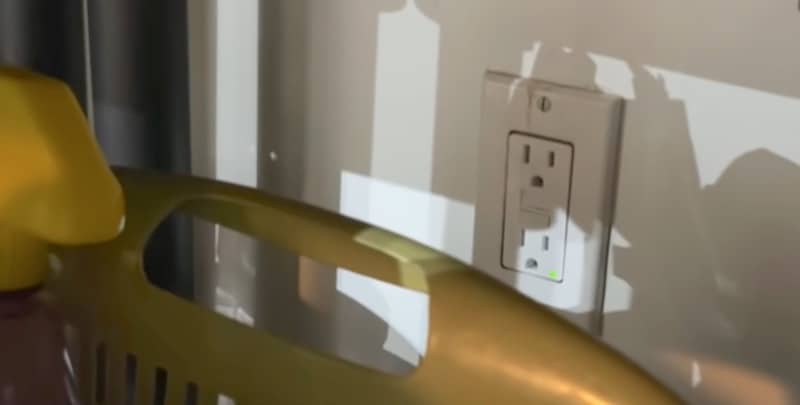
You can see that after resetting the GFCI the green light is on.
All the outlets on this circuit are working again and I can recharge my chain saw.
Troubleshooting Tip #3: Check GFCI Breakers
Our last troubleshooting method is a combination of the previous two — checking the electrical panel and resetting a GFCI.
We’re back at the electrical panel.
Depending on the age of your electrical system, you might have GFCI capabilities built into your circuit breakers, or something called AFCI.
What is AFCI and What It Protects Against
AFCI is a bit different than GFCI. AFCI checks for arcing within the circuit. Arcing is when electrical current starts jumping where it shouldn’t, usually between conductors in an electrical box where you have outlets, lights switches, and wire connectors. It’s extremely dangerous and is the leading source of electrical fires; that’s what the AFCI is there to protect you from.
Resetting the GFCI-Protected Breaker
Back to our GFCI-protected breaker at my electrical panel, which is identified by the bright yellow “Test” button on the breaker.
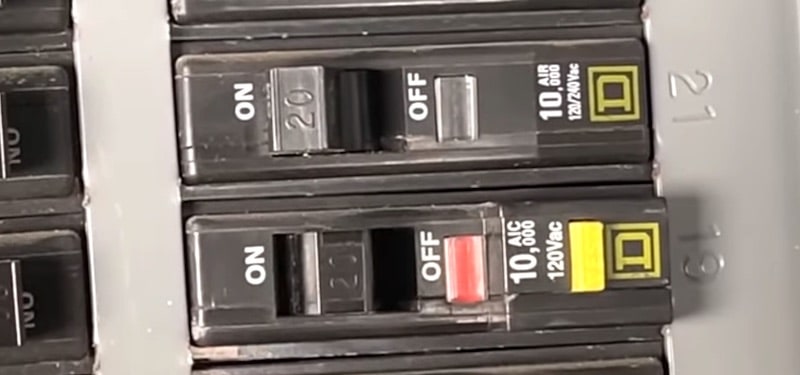
If I press the test button on the breaker switch, you can hear it trip. It looks like a normal tripped breaker, with the orange indicator being revealed and the lever moving to the central position between OFF and ON.
A breaker may trip because I’ve exceeded the amperage threshold of the circuit (in other words, I’ve plugged in too many things and overloaded the circuit) or because a ground or arcing fault has been detected. In any case, moving the GFCI-protected breaker lever to the OFF position and then back to ON is going to reset the circuit and restore power to outlets.
If Outlets Still Aren’t Working: GFCI May Need Replacing
If after trying these three troubleshooting methods your outlets still aren’t working, the problem might be that a GFCI receptacle won’t hold the reset. These components do have a limited lifespan. It might just be time to swap out the receptacle.
If you’re new to electrical work, have no fear! This is an easy repair that any do-it-yourselfer can tackle with confidence.
Check out this video, where I walk you through Replacing a Standard Outlet with a GFCI Outlet.
Our article 10 Things You Didn’t Know About Receptacles might be of interest as well.




